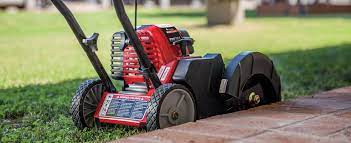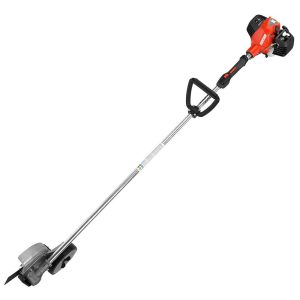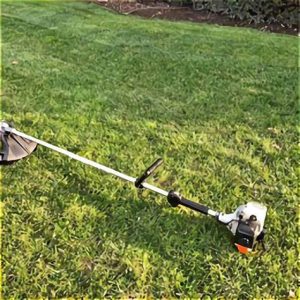6 Explanations Why Your Edger Requires the Choke to Function
An underlying problem needs fixing if you have to keep the choke lever halfway on to keep your edger running.
Only when the fuel/air ratio is off will an edger run with the choke engaged.
This can happen if you’re using stale gas, there’s a leak in the fuel line, the air filter is blocked, the carburetor is unclean, the carburetor gasket is leaking, or the fuel vent is blocked.
It’s important to remember safety measures when operating your edger. Taking off the spark plug wire is part of this process.

Before diagnosing, repairing, or operating, be sure you’ve read and understood all of the safety recommendations in the equipment’s operator’s manual.If you don’t feel confident in your ability to conduct the repair safely due to a lack of experience, training, or health, it’s best to call in an expert.
Table of Contents
6 Reasons Why an Edger Cannot Be Used Without the Choke
An Edger with Stale Gas
If you let gas sit in your edger for too long, varnish and sticky deposits can form, reducing fuel flow.
Using the correct gasoline in your edger and taking care of that fuel will reduce the likelihood of any issues arising from the fuel.
Only use fresh fuel in your edger, as gas starts to degrade after 30 days.
You should use gas that has an octane value of 89 or higher and no more than 10% ethanol. Engine damage can occur when using gas with a greater ethanol level.
Two-cycle edger engines call for oil to be blended with the fuel. The 4-cycle engines found in edgers need to be fed only gasoline (no oil). Except for STIHL’s 4-MIX engine, of course.
SOLUTION: Drain the gas from your old edger. To stabilize the gas, clean the fuel system, and decrease moisture, you should add new gasoline with an additive like Sea Foam or STA-BIL.
Broken Fuel Line or Clog
If the edger is sucking in extra air, check the fuel line for a hole or puncture. The engine’s air intake will have to be restricted, so make sure the choke is on.
Inspect the fuel line for blockages as well.
SOLUTION: Discard any damaged or cracked gasoline lines and replace them. If you discover a blockage in your fuel line, you can try to clear it with carb cleaner and compressed air.
Fuel Filter Is Clogged
A fuel filter that becomes clogged can also reduce fuel flow. To keep dirt and other particles from entering the fuel system and the engine, a fuel filter is installed.
It’s possible for the filter to become clogged if it’s not changed frequently or if you’re using particularly unclean fuel. The fuel filter should be replaced once a year to ensure proper upkeep.
SOLUTION: Replace a clogged fuel filter. The filter can be found inside the gas tank. Before removing the fuel tank cap, give the area a quick wipe down to prevent dirt from entering the tank. Take the tank’s filter out.
Using a clean, bent wire, you can “fish” the filter out of the tank. Take off the old filter, replace it with a new one, and reinstall it at the gasoline tank’s end. Put the gas cap back on.
To prevent such issues, make sure the filter is installed in the tank properly.
Carburetor Gasket Failure
The gasket protecting the area behind the carburetor is susceptible to wear and breakdown. When this happens, the seal breaks and air gets in, making the engine perform poorly due to a lack of fuel.
This condition occurs when there is more air than fuel in the combustion chamber.
SOLUTION: Remove the linkages and nuts holding the carburetor in place to gain access to it. Take off the gasket and carburetor.
After replacing the gasket, the carburetor, bolt, and links can be reattached. While the carburetor is out of the edger, you may want to give it a good cleaning.
Polluted Carburetor
In order to initiate and maintain operation of the edger, the carburetor controls the ratio of fuel to air used in combustion.
The carburetor’s ability to deliver gasoline to the engine can be impaired by the accumulation of varnish and deposits.
SOLUTION: If you have a basic understanding of mechanics, you need to be able to clean your carburetor. The carburetor needs to be disassembled and cleaned with carburetor cleaning to get rid of old fuel deposits.
It may be necessary to rebuild or replace the carburetor if it fails to function after being cleaned.
It may be more cost-effective to buy a new edger than to replace the carburetor on an older one, depending on the model you use and the cost of the part.
If you don’t feel confident doing it yourself, you can take your edger to a small engine repair shop to have the carburetor serviced or changed. Keep in mind that the repair company may opt to replace the carburetor rather than clean it.
Nothing terrible can come from this. The cost of a new carburetor may be the same as or greater than the cost of the work required to remove, clean, and reinstall the old one.
Fuel Vent Plugged
To maintain a constant internal pressure, the fuel tank must be vented. Without a vent, the fuel tank will develop a vacuum, blocking the edger from receiving any gasoline.
If your edger runs for a few minutes but then turns off and won’t start again unless you remove the fuel cap, this could be a sign of a problem with the fuel tank vent.
After a few minutes of operation with the gasoline cap replaced, it automatically turns off.
Depending on the make and model of your edger, the vent may be in the gasoline cap or a separate piece connected to the fuel line.
SOLUTION: Remove the fuel tank vent or cap (depending on your edger model) to allow air to enter the fuel tank.
Read more: Edger







